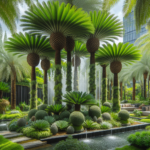[ad_1]
Creating a Tropical Oasis: Landscaping with Amargo Palm
When it comes to creating a tropical oasis in your backyard, few plants are as iconic and versatile as the Amargo Palm (Pseudophoenix sargentii). With its stunning fronds and elegant trunk, the Amargo Palm is a quintessential tropical plant that can transform any landscape into a lush, vibrant paradise. In this article, we’ll explore the ins and outs of landscaping with Amargo Palm, from caring for these beautiful plants to sourcing them and integrating them into your outdoor space.
Caring for Amargo Palm
Before diving into the landscaping aspect, it’s important to understand the basic care requirements for Amargo Palm. This will ensure that your plants thrive and stay healthy, adding a touch of tropical beauty to your landscape for years to come.
Amargo Palms are native to the Florida Keys, where they thrive in hot, humid climates. As such, they are best suited for USDA hardiness zones 10-11, where temperatures remain consistently warm throughout the year. If you live in a colder climate, you may need to provide winter protection for your Amargo Palms, such as wrapping them in frost cloth or bringing them indoors during the coldest months.
In terms of sunlight, Amargo Palms prefer full sun to partial shade. They should be planted in a location that receives at least six hours of direct sunlight per day. When it comes to soil, these palms prefer well-draining, slightly acidic soil. Amending the soil with organic matter, such as compost or peat moss, can help improve drainage and provide the essential nutrients that Amargo Palms need to thrive.
It’s also important to water Amargo Palms regularly, particularly during the dry season. While they are relatively drought-tolerant once established, they will benefit from regular watering, especially during periods of prolonged heat and dryness. Be sure to water at the base of the plant to avoid wetting the foliage, which can lead to fungal diseases.
In terms of fertilization, Amargo Palms benefit from a balanced fertilizer that is formulated for palms. Apply the fertilizer according to the label instructions, typically in the spring and summer months when the plant is actively growing.
In terms of pests and diseases, Amargo Palms are relatively low-maintenance and resistant to most common pests and diseases. However, keeping an eye out for signs of stress or damage, such as yellowing fronds or trunk lesions, can help you address any issues promptly and keep your palms healthy and beautiful.
Sourcing Amargo Palm
Once you’re familiar with the care requirements for Amargo Palm, the next step is to source these stunning plants for your tropical oasis. There are several options for finding Amargo Palms, from local nurseries to online retailers.
Local nurseries are often a great place to start, as they may carry a variety of palm species, including Amargo Palm. Visiting a nursery in person allows you to select healthy, robust plants and get advice from knowledgeable staff on caring for your new additions.
If local nurseries don’t carry Amargo Palm, or if you’re looking for a specific size or variety, online retailers can be a great option. Many reputable plant sellers offer a wide selection of palms, including Amargo Palm, and can ship them directly to your door. When purchasing plants online, be sure to choose a reputable seller with positive reviews and a strong track record of delivering healthy, high-quality plants.
When selecting Amargo Palms, look for plants that are well-established with a healthy root system and vibrant, green fronds. Avoid plants with yellow or brown foliage, as this can be a sign of stress or disease. Additionally, consider the size and growth habit of the palms, as this will impact their suitability for your landscape design.
Using Amargo Palm in Landscaping
Once you have sourced your Amargo Palms and familiarized yourself with their care requirements, it’s time to start integrating them into your landscape. Amargo Palms are incredibly versatile and can be used in a variety of ways to create a stunning tropical paradise in your backyard.
One of the most common uses of Amargo Palm in landscaping is as a focal point or specimen plant. Planted on its own or in groups, an Amargo Palm can command attention with its striking fronds and elegant trunk. Consider placing palms near a pool, patio, or entryway to create a dramatic, tropical ambiance.
Amargo Palms also work well as part of a mixed border or tropical garden. Pair them with other lush, exotic plants such as bird of paradise, philodendron, and bromeliads to create a dynamic, textural landscape. The contrast between the feathery fronds of the palms and the broad leaves of other tropical plants can add depth and interest to your outdoor space.
For a more formal look, consider using Amargo Palms in a symmetrical planting scheme. Flanking a walkway or driveway with evenly spaced palms can create a sense of grandeur and elegance, particularly when combined with manicured hedges or colorful flowering shrubs.
In addition to their aesthetic appeal, Amargo Palms can also provide practical benefits in the landscape. Their dense foliage can provide shade and privacy, making them an excellent choice for creating a secluded retreat within your yard. Additionally, the sound of the wind rustling through the palm fronds can add a soothing, tranquil atmosphere to your outdoor space.
When planting Amargo Palms, be sure to give them plenty of room to grow. These palms can reach heights of 10-20 feet and have a spread of 6-10 feet, so be sure to space them accordingly to allow for their mature size. Planting them too close together can lead to overcrowding and competition for nutrients, resulting in stunted growth and decreased vigor.
In terms of maintenance, Amargo Palms are relatively low-maintenance once established. Regular watering, fertilization, and occasional trimming of dead or damaged fronds are typically all that’s required to keep them looking their best. However, it’s important to monitor for signs of stress or disease, particularly during periods of extreme weather or environmental changes.
In conclusion, Amargo Palm is a stunning, versatile plant that can transform any landscape into a tropical oasis. With the right care and attention, these palms can thrive in a variety of settings, from sunny, coastal gardens to humid, subtropical landscapes. Whether used as a focal point, part of a mixed border, or to create shade and privacy, Amargo Palm adds a touch of exotic beauty and elegance to any outdoor space. So, if you’re looking to create a lush, vibrant paradise in your backyard, consider incorporating Amargo Palm into your landscape design – it’s sure to make a breathtaking statement and transport you to a tropical paradise every time you step outside.
[ad_2]




